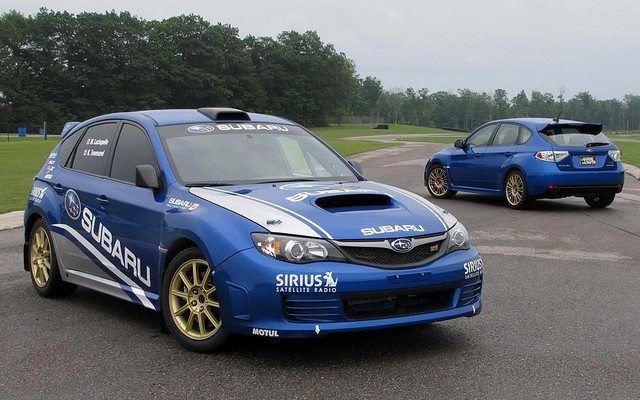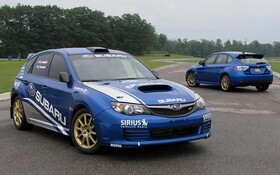The Subaru STI Targa and the production STI head to head at Mosport
With their turbocharged boxer engines, all-wheel drive, solid bodies and great reliability, Subaru’s WRX and STI models have long been prized by driving and rally racing enthusiasts alike. These and numerous other variations of them produced by the automobile branch of Fuji Heavy Industries have also developed a cult following in Japan and Europe, mainly because of Subaru’s serious commitment and tremendous success in the World Rally Championship.
A long time coming
The first WRX models were launched in Japan in 1992, but North American fans had to wait ten long years before this series made its way here. The STI version, with its more powerful engine, big spoiler and massive air intake on the hood, came on the scene in 2004 and the “Subies” popularity hasn’t stopped growing since. Drivers like Travis Pastrana and Ken Block have drawn a lot of attention to Subarus in rally racing and at X Games. Block, founder and head honcho of DC Shoes, has become a Internet star with his crazy Gymkhana videos, and racing simulators like Gran Turismo, where the WRX and STI are very common, are undeniably popular and influential with young people.
In Canada this year, Subaru is defending its national rally car title with Patrick Richard at the wheel of an STI and Alan Ockwell as co-driver. But the Japanese manufacturer has been pursuing another goal for seven years: to become the first to win the overall title at the Targa Newfoundland road rally with a car in the Modern division. Subaru has had its share of victories in its category but the overall win has always gone to a car in the Classic division (made before 1981). Keith Townsend came closest with a third place finish in his own, virtually unmodified production STI and Jen Horsey as co-driver. They finished 12 seconds behind the winner after five full days of competition.
A very special STI from the get-go
This year, Subaru Canada entered a WRX STI fully prepared for the race by Stewart Hoo (pronounced “Ho” and not “Hou”) of Can-Jam Motorsports in the 8th annual running of the Targa Newfoundland. I was driving this car for my third rally on “The Rock” with Keith Townsend as first co-driver. Keith and I prepared for this event for weeks, and took long rides in Newfoundland to analyse and identify the most difficult parts of the rally.
The current generation WRX STI that we used in the race had finished fifth overall in last year’s Targa. It was built from scratch by the Canadian rally champion Patrick Richard for his own use, so it had none of the interior features and accessories of the production STI, like ABS brakes, which are useless for gravel rallies. Instead, he installed a safety cage and a fuel cell. So the decision was made to enter this car in the Targa, a competition held on some 2,200 km of asphalt roads, with occasional patches of sand and gravel, and the car did quite well despite a few braking and suspension problems.
Stewart Hoo and his team made several modifications to this already very unique STI to make it better suited to the rigours of the Targa and to improve performance, handling and reliability. To verify the effectiveness of these changes and because the STI is radically different from the car that I had previously driven in Newfoundland, a trial session was a must. I took advantage of our track time at the 2.4 km long trial circuit at Mosport to measure the STI Targa’s performance gains and vehicle handling compared to a pure 2009 production WRX STI.
A lot of muscle with the production turbo
In the production version, the STI engine features 305 horsepower at 6,000 rpm and 290 lbs-ft of torque at 4,000 rpm. Stewart Hoo estimates the STI Targa’s power at roughly 450 hp and 450 lbs-ft of torque. He bases these figures on the 344 hp measured at the wheels on a dynamometer just before our test day. The engine of more robust versions is equipped with vital components such as forged pistons, a larger aluminium radiator and higher-performance oil cooler to reliably control the additional power.
On the track, the STI Targa’s large engine torque and practically “lag-free” turbo are impressive, and there’s no need to use the anti-lag system, a holdover from its conception as a pure rally car. The STI Targa went from 0-100 km/hr in 3.98 seconds in our acceleration measurements recorded with a VBox Mini linked to the GPS network. It took the production STI 5.5 seconds to cover the same distance. Stewart Hoo told me afterwards that I had only about 80-85% throttle in the Targa. In fact, the linkage had to be modified again due to the changes made to the racing pedals.
So, the STI Targa has the muscle but it also has the lively and precise reactions of a race car with few of the typical shortcomings of this kind of machine. Although it has practically the same ground clearance as the production model, it feels low and stocky on the track and it demonstrates less roll in turns and better roadholding, despite the Targa’s 235/45 R17-size Toyo Proxes RA1 tires that are higher and more narrow than the production STI’s 245/40 R18. The bumpy and sometimes potholed routes of the special sections in Newfoundland necessitate this precaution to avoid broken rims and flat tires.
The ultimate measurement
A track is the ideal place to evaluate a car’s handling, performance and braking, as well as its balance and reactions. I drove two sessions of 10 timed laps at the wheel of each car. My best time in the production STI was 59.48 seconds, which compares favourably with the 60.61 seconds recorded a year earlier on the same track with the Lexus GS 450h that I drove the two previous years in Newfoundland. It’s definitely a bigger and heavier car, but it proved to be very fast at Targa. Moreover, my best time in the STI Targa was 56.42 seconds, a significant difference for a circuit of this length.
The production STI was easy to drive fast and it was very predictable on this circuit, and the only limitation was the brake stamina. Near the end of the second set of 10 laps, the pedal stroke was considerably longer and very soft because of overheated brake pads. Once the car cooled off, everything went back to normal.
I did almost a hundred laps in the Targa that day and brake endurance was never an issue. In fact, we used the same Performance Friction ceramic brake pads that lasted the whole Targa the previous year. It had the same Brembo callipers as the production STI. However, the team installed new floating discs after the trial day because of the high speed we were going to reach in some of the Targa 2009’s forty-five special sections.
The current production STI was noticeably smooth and docile on the short track at Mosport, but I admit that I missed the livelier direct reactions of the previous model. The new one is definitely targeting a much larger public.
A real thoroughbred
However, the STI Targa has personality and then some, and its reactions are as sharp as those of a race horse. The metal or hard plastic bearings of its modified suspension make it more sensitive to the slightest adjustment. The ferocious acceleration and near total absence of the feeling of speed, combined with the fact that I didn’t notice any reaction to the rough, undulating roads that are so common at Targa Newfoundland took me by surprise from the very first special section of the Prologue.
The car jumped after a groove in the middle of a fast turn, slipped to the outside and hit a low wall almost flush on the side. My co-driver Keith Townsend woke up the next morning with the sharp pain of cracked ribs, and although my left thumb was sprained and I was rather stiff, I was able to get behind the wheel for the official start of the competition Monday morning. Stewart Hoo, our head mechanic, was also going to make his debut as co-driver after making the STI Targa race-worthy all night with the team’s mechanics Lewis Myers, Nick Searancke and Andrew Sorensen.
The rally’s motto has always been “press on regardless” and that’s exactly what the Subaru Targa rally team did over the five days of competition that followed. After Stewart performed a few more miracles, we finished in 12th place overall. We also won the Churchill Trophy, which is awarded to the best three teams from the same country. It’s a sort of Targa Nations’ Cup, so to speak.
In the end, our STI did not become the first car in the Modern vehicle class to finish first overall at Targa Newfoundland, but the superb 620-hp Nissan GT-R driven by Steve Millen and co-driven by Mike Monticello didn’t win it either. They won the Modern division, had the best times in most of the special sections but couldn’t do any better than 6th overall.
In spite of everything, I still believe that Subaru should create a special Targa version of the STI that would benefit from some of Stewart’s performance and handling tricks. This time, I’m sure that testing would include a great deal of time on the winding and bumpy asphalt roads that are so abundant from one end of the country to the other. Solid, fast and agile, this all-wheel drive STI is a performance car for the real world. The sharper it is, the better it will be.











